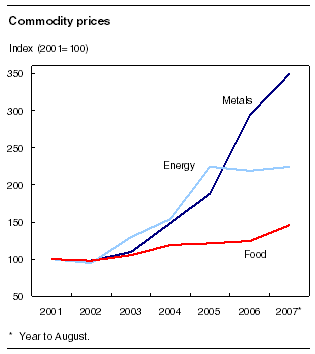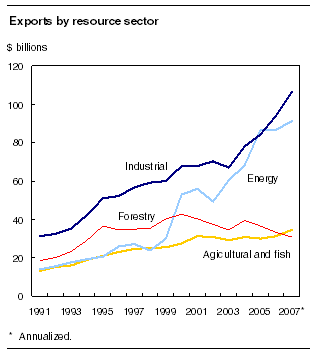Common menu bar links
Study: The new underground economy of resources
Archived Content
Information identified as archived is provided for reference, research or recordkeeping purposes. It is not subject to the Government of Canada Web Standards and has not been altered or updated since it was archived. Please "contact us" to request a format other than those available.

The characterization of Canada's resource sector as "hewers of wood and drawers of water" is outdated, according to a new article that challenges several myths about the nation's resource base.
The article, published today in Canadian Economic Observer, shows that the economy has rediscovered its resource base over the last five years, thanks to an historic surge in commodity prices now in the midst of their longest and strongest upswing ever.

The article focuses primarily on export earnings and prices, which capture the magnitude of the surge in commodity demand more than the volume of output or employment.
It shows that since 2002, there has been a large shift in the resource sector away from trees and water. Metals and energy products found underground now drive the growth of resources. Oil output has shifted from conventional oil and gas to the oilsands. Precious metals are more dependent on diamonds, as gold mines are depleted. Grain producers are moving from wheat to canola in response to changing consumer tastes.
As a result, it is more accurate—if less catchy—to say that Canadians are "conveyers of crude and moilers of metals."
The surge in commodity prices started in 2003 in the energy sector, where prices doubled before leveling off in 2005. By 2005, the boom became more pronounced for metals, where prices more than tripled between 2002 and 2006. By 2006, the upswing had spread to agricultural products, where a doubling for grain boosted farm prices by 50%.
While the details for each commodity are different, one common theme is a global economy in its fastest five-year period of growth since 1970. China's manufacturing growth, with a concomitant demand for natural resources used as inputs, has been particularly important.
The article also debunks the myth that Canada exports too many of its metal ores without further processing them. It found that industries such as metals and grains are leaders in adding value here in Canada.
Commodity boom began in energy sector
The commodity price boom began in the energy sector. At the start of 2003, energy exports were only Canada's fourth-largest export group. Quarterly revenues from crude oil and natural gas exports were nearly equal, at just over $4 billion.

Over the next three years, natural gas grew faster than crude oil, largely due to stronger prices. By late 2005, energy products were Canada's most lucrative export.
However, since 2005 these two energy industries have gone in markedly different directions. Crude oil exports have jumped a further 50%, as record-breaking prices were reinforced by new projects coming on-line.
Meanwhile, natural gas prices and production have plummeted, as a mild North American winter in 2006 created a surplus of inventories that still persists.
Compounding the problems of the Canadian gas industry has been the sudden emergence of liquefied natural gas (LNG) as an alternative source in US markets. LNG imports into the United States rose 58% in the first seven months of 2007 compared with the same period in 2006.
This US$1.6-billion increase was matched exactly by a drop in Canada's natural gas exports to the United States over the past 12 months. The growth in LNG reflects improvements in transportation facilities as well as the construction, in the United States and supplying countries, of terminals that convert it from gas to liquid and back to gas.
Overall, exports of other energy products (including hydro-electricity) have changed little since 2002.
Price increase for metals "stronger for longer" than even energy
Metals prices quickly followed energy in taking off after 2002, although the increase for metals has been "stronger for longer" than even energy.
Prices for a wide range of metals have set new records, including nickel, copper, zinc, and iron ore. Non-metallic minerals also have soared, notably potash, uranium and diamonds. Altogether, metals and minerals account for the bulk of exports of industrial goods.
Largely as a result of higher prices, industrial goods have become Canada's leading export. The turnaround was most pronounced for metal ores and alloys, where exports have doubled in four years after almost a decade of no growth.
One myth is that Canada exports too many of its metal ores without further processing them. Supposedly, this costs the economy by not "moving up the value chain." However, it is not a good description of how the mining industry operates in Canada.
In 2006, Canada exported $40 billion of metal alloys (which are ores refined to a finished or semi-finished state), compared with $11 billion of ores which require smelting and refining.
What is less well known is how much metal Canada imports for further processing. Overall, Canada imported nearly $10 billion of metal ore in 2006. About one-third was gold, mostly from Latin America, which was refined in Canada and then shipped to the UK. Another 15% was alumina, used as an input in the production of aluminum, most of which was exported. At $9.5 billion, aluminum was Canada's leading metal export in 2006.
The lesson to be drawn is that metal ore is processed in Canada when the economics justify firms doing so, regardless of where it is mined.
Farming, fishing and forestry
Agriculture and fishing have long been major components of Canada's resource sector, and remain by far the largest employers in this sector.
Still, low prices and supply disruptions (notably the moratorium on cod fishing and the "mad cow" outbreak) depressed incomes for much of the last two decades, leaving agricultural exports the smallest in the resource sector for much of this period.
Agricultural markets improved sharply in 2006 and 2007. Grain exports nearly doubled in value from their drought-affected low in 2005. The largest increase was for wheat, where prices hit a record US$9 a bushel in the summer of 2007.
Canola is the fastest-growing grain export, notably in oil form as consumers shift away from trans fats. Since 2002, exports nearly doubled to a record $1.8 billion in 2006 and are set to break that mark in 2007.
Fish exports have nearly doubled since 1990 despite the collapse of the cod industry in the early 1990s. The industry has adapted, most notably by accelerating the switch from groundfish to crustaceans (such as crabs, lobster and shrimp) and molluscs.
By the 2000s, exports of shellfish had grown to over $2 billion, accounting for well over half of all fish exports. This was four times higher than their level in 1991.
The decline of forestry exports in absolute terms has significantly lowered the relative importance of forestry products. As recently as 1998, they were Canada's largest resource export, ahead of metals, energy and agriculture. But by the first half of 2007, they trailed the other three.
As a result, the share of forestry products slid from 10.8% of total merchandise exports in 1998 to just 6.5% by mid-2007. Forestry had accounted for 18% of exports in 1978.
Resource boom reflected in higher output and jobs
Much of the recent growth in resource incomes has been driven by higher prices. Still, the resource boom has also been reflected in increased real output and employment in this sector. But output in some sectors has been more responsive to higher prices than others.
In volume terms, output in the primary sector, which increased 11.8% from 2002 to mid-2007, has not kept pace with the overall economy, which went up 13.7% in the same period.
In terms of employment, however, the primary sector has grown marginally faster than the total (11% compared with 9.8%).
The largest expansion in output since 2002 has been in mining, excluding oil and gas. Non-metallic minerals drove the advance. Initially, the increase reflected the continued development of diamond mines in northern Canada. More recently, output of potash has risen in response to high prices.
The turnaround for metals followed a decade of decline, unlike the repeated boom-bust movement of energy prices. Perhaps because of the memories of this protracted decline, investment and output in metals and minerals have been slower to respond to the boom than in energy.
It is often asserted that one of the downfalls of a growing reliance on resource-based industries is their "boom-bust" nature. However, examining the variability of output and export earnings yields an overall impression of stability compared with the rest of the economy.
The study, "The new underground economy of resources", is included in the October 2007 Internet edition of Canadian Economic Observer, Vol. 20, no. 10 (11-010-XWB, free), now available from the Publications module of our website. The monthly paper version of Canadian Economic Observer, Vol. 20, no. 10 (11-010-XPB, $25/$243) will be available on October 18.
For more information about the Canadian Economic Observer, click on our banner ad from the Publications module of our website.
For more information, or to enquire about the concepts, methods or data quality of this release, contact Philip Cross (613-951-9162; ceo@statcan.gc.ca), Current Economic Analysis Division.

